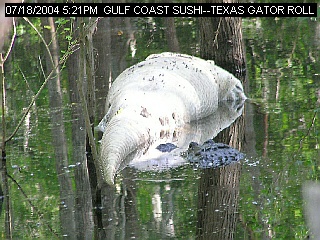
IT ALL COMES AROUND
Alligators usually follow a series of non-violent
behaviors when interacting with each other. But they are animals,
not machines, just like we are. People, which are supposed to be
"civilized",
may react savagely if provoked in the right way. The same can be
said for any of our domestic animals. Occasionally, even alligators
will react violently towards each other. It is foolish to
provoke any wild animal, regardless of size or disposition. The
animals have a right to live in their habitat, and humans can share
it with them if they take the time to understand the
animals.
----------------------------------------------------
IT
ALL COMES AROUND
On Sunday morning, I went out to look for it, and
found it along the Spillway Trail, near a concrete culvert. As
disturbing as this dead alligator looks (It's a bit distressing
that an alligator this
large is dead.), the sight is NOTHING compared to the smell.
The carcass was right next to the culvert (see BLOATED FLOATER,
below). I was surprised and a little disappointed that there
were no alligators feeding on the carcass, but I took a few
pictures anyway. As I was walking away, I turned and looked back
at the dead alligator one more time, and I saw it
move...almost
like it was drifting with a current. But, there was no
current! When I went back and looked down, I saw this
ten-foot alligator (see NOT QUITE DRIFTING, below) holding onto
the tail. The
water in this part of the Pilant Slough is often tinted dark by
leaves. The live alligator was resting underwater, and its dark
color was invisible in the dark, shaded water. As I watched,
it
submerged again (see MY FLOATING DINNER, below). The last image
(LIVE ANCHOR, below) is a closer, cropped version of the same
image. The alligator finally submerged totally,
and I watched the carcass get towed away. I had this mental image
of the alligator towing this meal like a kid with a balloon. At
this time, it began to rain, and I also had to give a program
in the VC/NC, so I left the area.
--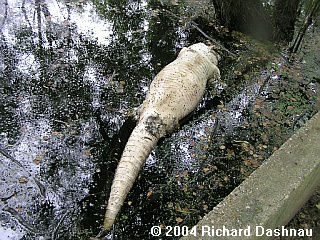 -
-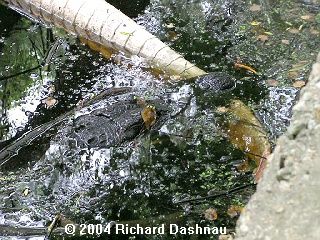 -
-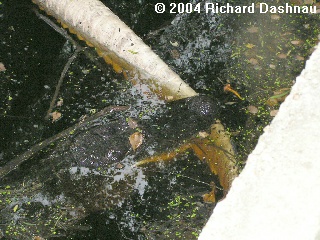 -
-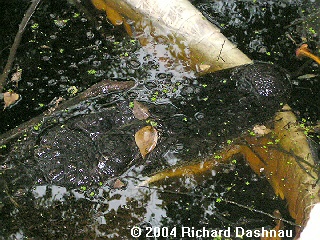 -----
-----
REALLY BLOATED
FLOATER
NOT QUITE
DRIFTING
MY FLOATING DINNER
LIVE ANCHOR CLOSER
Later, after my program,
one of the park visitors mentioned the dead alligator, and said
that another one was actively feeding upon it. So, I went back to
take a look. Today's RICKUBISCAM
shows the large alligator swimming towards this gruesome pi´┐Żata
(when this thing bursts, LOOK OUT!). I didn't have my video camera
with me (sometimes it's just too much gear to load and
unload from the car, etc.), but I was able to get a few video
clips with my Olympus C750. The images below are single
frames from three sections of a single video clip. Part 1--PULL
AND
BITE, below, shows the alligator pulling the carcass (it was about
25 yards away), and then grabbing with its mouth and preparing to
spin. Part 2--SPIN OFF A PIECE, below, shows the
alligator going into its spin. This is amazing! I've never seen
one do it before, and I can't believe how fast the alligator
spins, and for how long! I didn't break this clip further because
I didn't
want to break the spin. Part 3--SWALLOW THE PIECE, below,
shows the alligator lifting its head so it can swallow what it has
torn off. Or, click this link to se the entire clip in one piece
: FULL
VIDEO
CLIP 2319 kb I
really hope we don't see any more dead alligators.
----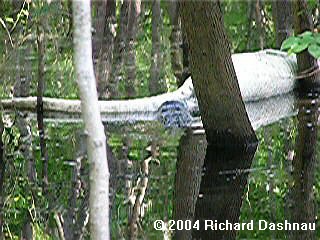 ----
----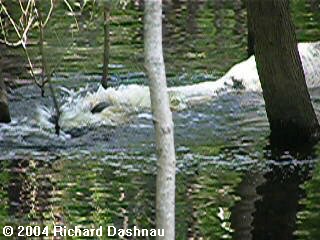 ---
---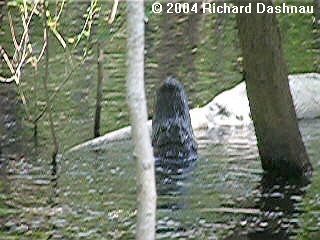 -----
-----
PULL AND
BITE
SPIN
OFF A PIECE!
SWALLOW THE PIECE
VIDEO PART 1
567 kb
VIDEO PART 2
1117 kb
VIDEO
PART 3 802 kb
July 12, 2004One other event worthy of note: During the week, a
number of park visitors reported seeing large dead
alligators (at least 6 feet long) being eaten by even larger
alligators.
Park Naturalist David Heinicke was able to witness a part of this,
and was even able to take pictures (see DEAD GATOR, below).
Unfortunately, I was unable to get to the park soon enough
to see any of this myself. It is thought that there may have been
2 or 3 alligators actually killed (not the 4 or 5 first thought),
and that as they were eaten, their carcasses were moved about the
park. Some bad news was that one dead alligator was a female that
apparently left a nest with live eggs. The eggs were taken and
will be incubated and hopefully hatched in captivity.
---------------------------------------------------------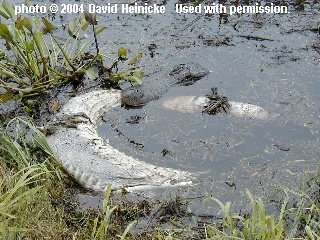
DEAD
GATOR
March 29, 2004 The image below (ALLIGATOR WRESTLING) shows that
one should never consider wrestling an alligator...even if one IS
an alligator. March 29 was a Monday, and I'd
taken a day off to go to the park to see if I could find any
alligator mating behavior to film. I didn't see any courtship, but
I did see *this*. For now, I'll just post this list of
events as I saw them,
with the clip numbers referenced in parenthesis. Not
ALL the clips are here. Note--6/7/2019--A
lot
has changed since I first posted this article 15 years ago. For
many reasons, video clips
from this time were small. Due to recent interest in some of
this material--due to social media--I've tried to upgrade the
video. For now, I've resized the original video
(from 352 x 240 to 800 x 600 ) and converted the format (from
.flv to .mp4). Hopefully this makes the clips watchable.
I've also made a few minor edits in the text-mostly because I
changed
the length of some of the clips. One more thing--I have
found the original camcorder tape with this footage! I will
transfer it to SP DVD, and then rip that into video files. This
should yield
even better quality video. I just have to make time to do
it. Until then, thanks for visiting! Rick D.
----------------------------------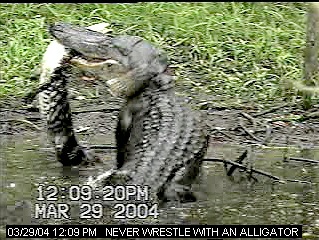
ALLIGATOR
WRESTLING!
The feeding alligator is
about 7 feet long and the small alligator is about 3 feet long.
My video record started at
about 10:43am(clip680).
As time progressed, I had to start and stop the video recording.
This was advisable because the alligator spent long periods of
time not
moving(perhaps resting). When the larger alligator began to move,
I'd resume filming. This worked out well, since I only had 20
minutes of video tape. Unfortunately, I missed the beginning
of the situation, so I don't know how or why the smaller alligator
was in this predicament. The large gaps of time represent periods
that the alligator remained still.
10:46-10:47 Large alligator continues chewing on the
neck and upper body of smaller alligator. Smaller alligator shows
movement--possibly reflexive-- rear-leg stepping and slow
tail
sweeping.(clip681)
11:03-11:04 Large alligator had moved back into
the water, and comes back out at this time. It crawls almost
entirely onto mudbank, chewing on and dragging small alligator
which it still
is holding by the "shoulder" area.
11:17 Large alligator still chews on shoulder area.
11:34 Alligator chews, then lifts upper body and does
first "whip" of smaller alligator. One time only. Rain clouds
moved into area at this time, so darkness falls.(clip684)
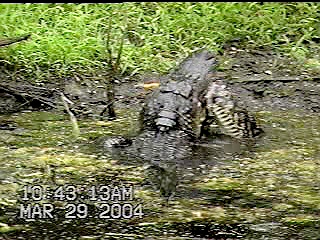 -
-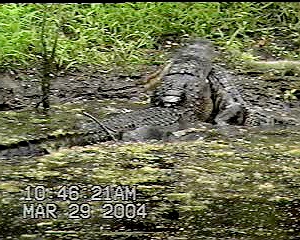 -
-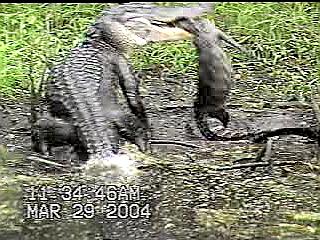 -
-
VIDEO CLIP
680 mp4
VIDEO
CLIP 681 mp4
VIDEO
CLIP 684 mp4
11:43 Alligator has backed
into the water, at the same time alligators have started bellowing
nearby (within 50 yards) in Elm Lake, and also further away. It
moves back onto mudbank, still
chewing shoulder area. 11:46 Alligator begins chewing, and
does second "whip". Carcass makes loud slap sound on mud bank.
11:52 Alligator does 3rd whip.
11:58 4th whip. 5th whip. No. 5 makes pop sound
against mud. Continues movement this time, takes a step backwards
(into water), then whip number 6. Number 6 makes LOUD pop
noise
against water.(clip687)
NEW CLIP ADDED 04/12/04:
"Whip Number 6" is shown in slow motion (link clip 687b). Seen this way, the movement
is much more graceful. The "whip" can be broken down into separate
parts. 1) First, he raises his upper body with his forelegs. This
lifts the prey off the ground and clears his body for rapid
movement. 2) He pushes forward with his rear legs, while cocking
his
head to the *left* side. 3) His upper body moves up,
forward, and then falls to the *right* side, which gives it
momentum. 4) As the body nears the ground (the right foreleg
touches the ground),
the alligator begins whipping his upper body and head in the
direction his body is falling--transferring the stored energy
through the rotation point of his neck towards the end of his
snout.
5) The alligator's body lays onto the ground, while the snout
continues whipping towards, and then past, his body midline( still
moving towards the right). The energy set in motion by the
large
mass of the alligator's body is now transferred to the alligator's
head, which is still moving in the direction started by the
fall. 6) the energy is now transferred to the carcass, as
the alligator
jerks its head back in the other direction (back towards the
left), so that stress is transferred to any leverage points that
are held in the alligator's jaws.This jerk to the left is assisted
by his
entire body pulling and curving to the left. This jerk is
either strong enough to move his body to the right, or he's taking
a slight step in that direction. With the continued "chewing" on
the
connective tissues to weaken them, this whip-cracking should
eventually cause the carcass to tear into smaller pieces.
At least, that's how
*I* see it. This is not unlike the physics used in some martial
arts movements, and I think it's pretty cool.
12:02 7th whip. This whip is also loud pop against water. 12:03 8th whip. Alligator steps forward and carcass hits ground, not loudly.
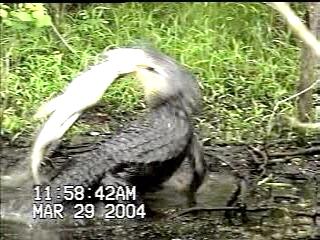 -
-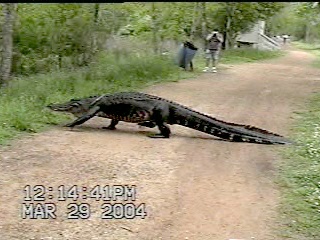 -
-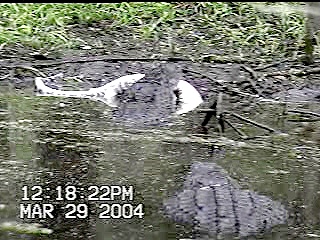 -
-
VIDEO
CLIP 687b slowmotion
VIDEO
CLIP 690 mp4
VIDEO
CLIP 691 mp4
12:09 9th whip. Alligator
steps back. 10th whip. Whip number 10 is LOUD against water.
Alligator still chewing head/shoulder area.
12:11 Around 12:09-12:10 Large alligator appeared
directly behind us on shoreline of Elm Lake. We moved people and
tripods at my request. 12:11, Large alligator walks mostly onto
bank and rests. 12:14 Large Alligator crosses trail and moves into
puddle. (clip690)
12:18 Moved tripod back to original position. Large
alligator moves upon feeding alligator from behind. It is perhaps
50 percent larger than feeding alligator. Feeding alligator runds
and
evades, submerging. Large alligator moves towards us, faces us,
shows tail arch. (clip691)
12:19 Feeding alligator reappears, and swims
off--still holding smaller alligator in its mouth. 12:22 Large
alligator pursues, until feeding alligator is forced into very
shallow water, where
it moves and hides in grass. Large alligator stops where water
still covers at least half of body (about 20 feet back from hiding
alligator). Body straigh, minor tail arch, with last 3rd of tail
swishing slowly back and forth. Large alligator eventually broke
off, and moved back into pond.(clip692)
- --------
--------
VIDEO CLIP
692 mp4
I'm very happy I
got to see all of this. I don't know what started the conflict in
the first place, although alligators normally move into that large
puddle (or small pond) to feed for a while before
moving back into a deeper body of water. Since I was
constantly pausing and filming with the camcorder, I couldn't get
any pictures with my still camera. I think that the slapping
noises
are what called the larger alligator. The "headslap" has a very
similar sound. There was another large alligator *behind* the one
that crossed, but it remained in Elm Lake, about 10 feet
from shore, and eventually swam off after the trail crossing.
This also illustrates the difficulty that an alligator has
separating prey into pieces that it can swallow. It was also
interesting that
the alligator held on to its prize (the smaller gator) even while
being chased.
The
date was September 4, 1992.
Donna was at Brazos Bend park, when she was alerted to living proof
of something that many
visitors to the park find unbelievable. That was the sight
of a large alligator (Donna estimated
it at about 10 feet long) that was eating a smaller alligator (about
4 feet long). No one had witnessed
the events leading to this ending, so any
reasons for the attack are strictly conjectural. Closeups in the videotape show that many flies had already made
an appearance, so the kill had probably been made some time before.
When alligators make a kill that is too large to swallow whole, they
will carry the carcass around,
sometimes for days, until it has softened enough to break up and
swallow. Click the link
below for a small clip showing
this.
Alligator
eating
another 14,593 kb (no sound) 
Note how much difficulty the large alligator is
having with the dead one. They are not "built" for attacking
large prey items. Their teeth are poorly-configured for tearing
flesh. Also, an alligator has very tough skin, and would be
difficult for almost anything to dismember. There is a good
possibility that this was the result of a territorial
dispute gone bad.
The
next day, September 5, 1992, Donna was once again at the right place
at the right time with a video camera.
This time, in Elm Lake at the park, the fish were dying off,
evidently due
to an algae bloom that had
depleted the oxygen in the water. The fish were congregating near
the surface of the lake. Lining up
for this free food were a huge number of alligators of all
sizes. Among the alligators in the park about this time were apparent strangers to the park. These
"visitors" seemed to be darker than most of the other alligators, and also were
apparently more aggressive. During the course of this video, one
alligator can be seen chasing
other alligators, away from this stretch of shoreline. In the
clip below, one of the territorial
conflicts takes place. Immediately after this clip, the alligators
both moved out towards deeper
water, where they tussled again. There is a large "clump" sound from
within the
disturbance, and only one
alligator immediately surfaced. Click the link below, next to the
image to see the first part of
this battle. These alligators are at least 10 feet long.
Alligator
territorial
conflict 2,959 kb (no sound) 
The picture above is one of a series of 32 images. Click on this link to see them. Alligator Territorial Dispute Sequence
As far as I could see from the video, there was
none of the usual evaluation of social status for either
alligator. The one just attacked the other. From what I've
heard
from witnesses there at the time, it seemed to be a very large
alligator that was attacking the others. It probably came to the
park from somewhere else (so wasn't born
there) and viewed everything else close to its size (including
humans) as interlopers in its adopted territory. It eventually
had to be destroyed because of this behavior.
This is very unusual
behavior for an alligator. Remember, almost every one who is
reading this is certainly living within 50 yards of a large
predator that attacks humans
by the thousands every year. At least two people were killed by
this predator in my home town over the last year. That
predator is the domestic dog. Our friend and
companion (I can't live without one), it can still attack
if provoked in the wrong way, and most attacks could be
prevented by better understanding of dog behavior.
However, such attacks are not usual dog behavior.
Neither is this aggression shown here normal among alligators.
Note that of all the alligators swimming around,
only one was aggressive.
A
little later on, Donna (who was standing quite close to the shore
during all this), noticed the alligator below
in territorial/aggressive posture. While she was filming, she
assumed at first
that this rather unwelcome
attention was focused on another alligator in the water near her.
However, not much later, it seems
fairly obvious that Donna herself was the creature that was
annoying the alligator. Fortunately, although
this alligator made a few passes near shore, and actually paused in
front of Donna a few times, it
never left the water and attempted to do
anything else. Click on the link near the picture to see the clip.
Alligator
aggressive
posture 7,165 kb (no sound) 
The picture above is one of a series of 37 images. Click on this link to see them.Alligator Aggression Display Sequence
And, this page shows alligators at the park, on land, near various landmarks at the park.
Go back to my main alligator page, Alligators
Go
back to my home page, Welcome to
rickubis.com
Go
back
to the See the
World page.